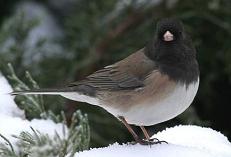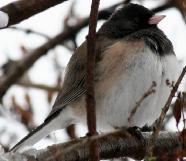Dark-eyed Junco
Identification and Pictures
 The
Dark-eyed junco is a small 5 to 6 1/2 inch
bird. There are several forms of juncos. Four
North American were separate until the 1970s when they were
all lumped together under Junco Hyemales. The
Dark-eyed junco is a small 5 to 6 1/2 inch
bird. There are several forms of juncos. Four
North American were separate until the 1970s when they were
all lumped together under Junco Hyemales.
Slate Colored Juncos are gray with white outer feathers that will flash
during flight. The male has a dark grey or blackish hood on
slate gray, with a whitish belly. Female and young ones
are duller. The young may have streaks on the breast. Most
have a pale pink bill.
Oregon junco 
Oregon Juncos have rusty colored sides, and
pink beaks. Males have a black hood with a rusty
back. Females have grayer hoods with pink or browns
sides. The rusty back is not as pronounced in
females. Younger birds are streaked below and grayish.
Pink Sided juncos have darker gray hood
with pink sides.
Photos by Keith Lee.
The camera I use is the Canon
EOS 40D.
Sound of Dark-eyed Junco
The male;s song is a musical trill with a
sharp tic, and twittering notes, said to sound like a ringing
telephone. Calls include a nasal kew-kew, a buzy
zeet, and a tick when the nest is threatened.
Dark-eyed Junco song: Click for Sound
Preferred Habitat
Dark-eyed juncos like cool forests of mixed
wood, and can be seen in undergrowth, brush, or along the
road. They range from Alaska, Canada, and U.S. They winter in much of the U.S., and
north Mexico.
In winter juncos can be seen in small flocks. seen in undergrowth, brush, or along the
road. They range from Alaska, Canada, and U.S. They winter in much of the U.S., and
north Mexico.
In winter juncos can be seen in small flocks.
Breeding and Nesting
Breeding begins in mid March to May with
double or triple broods. Breeding areas for Dark-eyed
juncos are open woodland, forest
edges, bogs, and mountainous regions. They winter in woodland
edges, and bushy areas.
The nest will often be on the ground, hidden
in brush or behind a rock or stump. They can also be found in
tree cavities, or on building ledges. The female usually
builds the nest in a hollow. The male may help by
bringing twigs etc. Material used is twigs, stems, fine grass,
and hair.
Eggs
There are usually 3 to 5 eggs incubated by the female for
around 13 days. Egg color is white, greenish or gray with
speckles or blotches. The speckles can be red-brown or
purplish brown. The young are tended by both adult birds, and
are able to leave the nest in 10 to 14 days.
Food and Feeding
They like to feed on the ground, hopping around to search
for seeds or insects. They will come to seed feeders.
For more on food
and feeding click here.
For more on feeders click here.
To learn about other favorite
birds click here.

|
